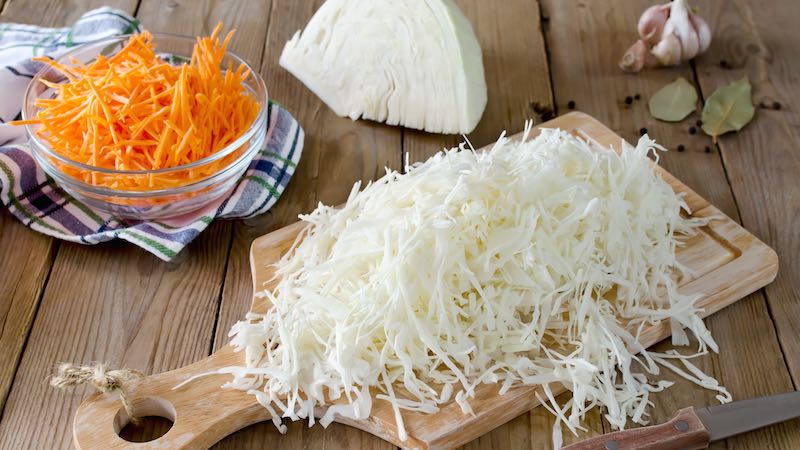Eat Homemade Sauerkraut Recipe To Fight Fat And Inflammation
Last updated on
When you think of sauerkraut, you probably do not think of it as a health food. This interesting item is often used on sandwiches and hot dogs to add a little texture to the meal.
The process of fermenting and preserving cabbage dates back to at least the fourth century BC. For over two thousand years, people have enjoyed this food, but why is it such as an important item? Made from fermented cabbage, sauerkraut is actually packed with iron and many beneficial nutrients.
Learn more about the health benefits of sauerkraut and then find out how to make your own, with an easy-to-follow homemade sauerkraut recipe.
The Power of Fermentation
Fermentation is a process that is applied to a wide variety of foods. It is essentially a process that is used to preserve food. During this process, natural probiotics are produced. These probiotics have been linked to a variety of health benefits, such as a stronger immune system and digestive system.
In order to ferment a food, the food is often combined with a yeast or bacteria to begin converting the glucose found in the food into healthy bacteria. Healthy bacteria in the gut is necessary for an overall healthier digestive system, immune system and overall wellbeing.
1. Probiotics Improve Digestion
One of the primary benefits of consuming more probiotics is that they can help to improve digestion. By supplying your gut with healthy bacteria, your digestive process is more equipped to destroy or remove harmful bacteria. These probiotics can also necessary for your body to absorb nutrients from the food that you are eating.
2. Fermented Food Can Boost Your Immune System
Your gut is your biggest protection against illness. As such, adding the healthy bacteria found in probiotics to your gut can strengthen your immune system. The spread of healthy bacteria in your gut can help control immune cells and prevent certain autoimmune reactions, such as inflammation.
3. Improve Brain Function With Probiotics
As with most bodily processes, your brain is connected to your digestive system. For an example of this, think about the last time you were sick with the cold or flu and how fuzzy your head felt. The vagus nerve is responsible for this connection.
The vagus nerve is one of 12 cranial nerves that transfers information from your intestinal nervous system to your central nervous system located in your brain. Maintaining a healthy amount of good bacteria and limiting unhealthy bacteria can keep this line of communication between the two systems open, preventing cognitive issues.
4. Probiotics Can Help Reduce Stress
Consuming probiotics can also help you reduce your stress levels. The probiotics help to release various enzymes and digestive substances that can improve cognitive processes and brain function.
With a healthy brain, you are more equipped to deal with and manage stress. Some studies suggest that the probiotics help produce serotonin and dopamine—which are needed for regulating your mood.
5. Lose Weight by Eating More Sauerkraut
Receiving help with weight loss is always a welcome benefit. Probiotics help regulate various hormonal functions. This may help you control your food cravings and suppress your appetite. Studies show that people with a high intake of probiotics tend to have a lower risk for obesity.
6. Sauerkraut is Packed with Iron
Probiotics are not the only reason to consume sauerkraut. The fermented cabbage is also a great source of iron. Iron is necessary for muscle health, brain function, and for preventing anemia, which can lead to fatigue, headaches, and weakness.
How To Make Sauerkraut With Only 3 Ingredients
Now, on to the recipe. If you are ready to try making your own sauerkraut, then simply follow these instructions. There are not many ingredients, but you will need specific equipment, such as mason jars with lids. The following recipe should yield between 1 and 1½ quarts of sauerkraut.
Ingredients
- 1 medium head of organic green cabbage (you may also use red cabbage)
- 2-3 organic carrots (optional)
- 1½ tablespoons of kosher salt (or Himalayan salt)
- 1 tablespoon of caraway seeds (optional)
Instructions
Before making your sauerkraut, you will need a few mason jars with lids. Make sure that they are completely clean. You should also wash your hands before you begin preparing the cabbage.
- Start preparing the cabbage, by removing any wilted or limp outer leaves. Cut the cabbage into quarters and then trim out the inside core of the cabbage. Slice each of the quarters down the length of the cabbage, so that you have eight wedges. Next, slice each wedge into thin strips. Place the ribbons of cabbage in a large mixing bowl.
- If you’d like to add carrots for some extra taste and color, grate them into fine strips and mix them in the large mixing bowl.
- Using your hands, you will combine the salt and the cabbage. Sprinkle the salt over the top of the cabbage and carrot ribbons. Start massaging the salt into the veggies. As you massage them, it will become watery, beginning to take on the texture of coleslaw. This should take between 5 and 10 minutes.
- If you want to flavor your sauerkraut, add the caraway seeds at this point. With your cabbage and carrots cut into strips and mixed with salt, you can begin placing the cabbage in your mason jars. Every so often, use your fist (or a food pusher) to press the cabbage down into the jar.
- Once the jar is completely full, place a clean cloth over the top of the jar. Secure the cloth with a rubber band. This allows air to pass through the jar, while preventing debris, such as dirt and insects, to enter the jar.
- Over the course of the next 24 hours, press the cabbage down every few hours. The liquid should eventually rise over the cabbage. If needed, you can add a little extra water. Ferment the cabbage for at least 3 to 10 days. Keep the jars away from direct sunlight and store them in a cool room. Remove the cloth and replace with a lid once you see that fermentation is complete.
Sauerkraut is not difficult to make, but you do need to keep an eye on it. If the cabbage does not begin to ferment, you can add a teaspoon of salt in 1 cup of water to help move the process along. You may not get it right the first time, but experiment with different techniques until you are satisfied with the taste.
References:
https://www.thekitchn.com/how-to-make-homemade-sauerkraut-in-a-mason-jar-193124
Some of the links I post on this site are affiliate links. If you go through them to make a purchase, I will earn a small commission (at no additional cost to you). However, note that I’m recommending these products because of their quality and that I have good experience using them, not because of the commission to be made.
Comments
Leave a Reply











































 JOIN OVER
JOIN OVER
I love sauerkraut, and it’s so cool to see it finally getting the attention it deserves! I tried to make my own once, but I was so dissapointed (and maybe a little spoiled by bubbies.com sauerkraut!) that I havne’t tried making it since. I love the idea of using different flavorings though, so I may try it again- thanks for the inspiration!
Hi Sara, thanks for this amazing site you have. Am loving reading through things and checking out new juice recipes 🙂
I have a question about sauerkraut and kimchi. I’m just wondering if it needs to be refrigerated once it’d ready to go or can it be stored in a cool place until you start eating it? I’ve made some before and have kept in fridge but takes up a bit of space when there’s a few jars in there. Thanks, Jodie.
Hi Jodie, I’m glad that you are enjoying the site! You can store sauerkraut and kimchi in glass jars with tight lids on, in cool dark places. Just be sure there is no contamination from using “unclean” utensils in it, to prevent mold, i.e. utensils used for other foods or touched by fingers, must not be used in these jars. Enjoy!